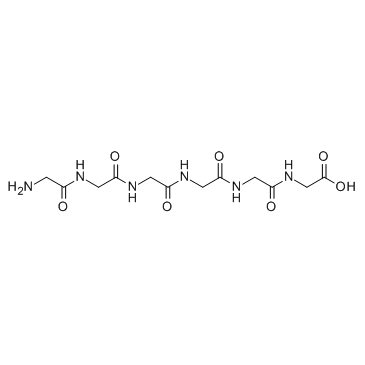H-Gly-Gly-Gly-Gly-Gly-Gly-OH

H-Gly-Gly-Gly-Gly-Gly-Gly-OH structure
|
Common Name | H-Gly-Gly-Gly-Gly-Gly-Gly-OH | ||
|---|---|---|---|---|
| CAS Number | 3887-13-6 | Molecular Weight | 360.32300 | |
| Density | 1.415 g/cm3 | Boiling Point | 1069ºC at 760 mmHg | |
| Molecular Formula | C12H20N6O7 | Melting Point | N/A | |
| MSDS | Chinese USA | Flash Point | 600.3ºC | |
|
Loss of internal backbone carbonyls: additional evidence for sequence-scrambling in collision-induced dissociation of y-type ions.
J. Am. Soc. Mass Spectrom. 25(10) , 1716-29, (2014) It is shown that y-type ions, after losing C-terminal H2O or NH3, can lose an internal backbone carbonyl (CO) from different peptide positions and yield structurally different product fragment ions upon collision-induced dissociation (CID). Such CO losses fro... |
|
|
Peptide quantitation with methyl iodide isotopic tags and mass spectrometry.
Analyst 135 , 1456-1460, (2010) A novel method is presented for the quantitation of peptides based on their methylation by in vacuo chemical reaction with methyl iodide. Samples of two small peptides, hexaglycine and pentaalanine, were labeled with CH(3)I and CD(3)I, representing the "unkno... |
|
|
Aggregation of capped hexaglycine strands into hydrogen-bonding motifs representative of pleated and rippled β-sheets, collagen, and polyglycine I and II crystal structures. A density functional theory study.
J. Phys. Chem. B 115 , 1562-1570, (2011) We compare the energies and enthalpies of inter-action of three- and seven-stranded capped polyglycine aggregates in both the pleated and rippled antiparallel and parallel β-sheet structures as well as the collagenic (three-strand) or polyglycine II-like (sev... |